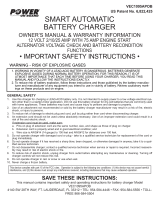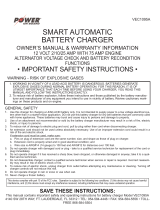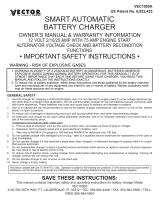Page is loading ...

Call Toll Free 800.775.5310
www.chargersdirect.com / Email: info@chargersdirect.com / Fax: 310.638.5024
10/09/06 Linear II Oper Inst
Anpat Electric Mfg. LLC
IPD International Power Devices
LINEAR II BATTERY CHARGERS
OPERATING INSTRUCTIONS MANUAL
PLEASE, READ ALL SAFETY INSTRUCTIONS BEFORE OPERATING THIS UNIT
INTRODUCTION:
The Linear II Battery Chargers are fully automatic. The input and output of the charger is
microprocessor controlled. The output is current limited for the protection of your equipment.
The following input/output specifications are subject to change due to design improvements:
OPERATION:
Always connect the battery charger to the battery prior to connecting to the
A/C source.
1) When the charger is plugged into an AC source, either 115, 208 or 220 volts 60 or 50 Hz, the
microprocessor will turn the charger on, after a 5 to 8 second diagnostic delay the green LED
will illuminate. This delay eliminates any output spike from the charger on the initiation of
charge.
The Green LED flashes rapidly while charging. It stops flashing when charge is completed
and stays on as a solid green light.
2) When the battery voltage reaches the 80% CHARGED level a the Yellow LED light will
illuminate.
3) The microprocessor continuously monitors the battery voltage and automatically adjusts for
the optimal finishing charge.
4) If the Red CHECK BATTERY light illuminates, this indicates a problem with the battery.
Possible causes: A. The battery has not reached the end of the first stage of the operation
within 16 hours. Check the battery for proper connections, possible battery internal failure.
B.The battery A/H capacity is too large for the charger’s output rating.
Actions to be taken:
Disconnect the charger from the A/C and wait a moment, reconnect the A/C to the charger. If
the charger begins charging again this may indicate that the A/H rating of the batteries
exceeds the charger’s rated output.
5) If the battery-operated vehicle is in storage for extended periods and the charger is connected
to a reliable AC source, the charger will reinitiate the charge cycle when the battery voltage
drops below a predetermined level as specified via programming.
6) When disconnecting the battery charger always disconnect the A/C before
disconnecting the battery.

1
Anpat Electric Mfg. LLC
IPD
International Power Devices, LLC
Battery Charger Safety and Operating Instructions
SAVE THESE INSTRUCTIONS:
This manual contains important safety and operating instructions for battery
charging. Before operating and using the Charger, read all instructions in the
manual and markings on any equipment the charger is used on.
! This Safety Alert Symbol Means Attention! Become Alert! Your Safety Is Involved
INSPECTION
Inspect the charger immediately upon receipt. If there is any indication of freight
damage, call the carrier for an inspection and file a claim for damage.
! CAUTION
! To reduce risk of injury, before you start charging your batteries verify the
charger is the correct one for the type of batteries in your machine or vehicle!
! If your equipment has any type of sealed batteries never use a charger that is not
specifically designed or programmed for such batteries.
! Keep exposure of charger to moisture to a minimum.
! Use of any attachment not recommended by International Power Devices may result
in risk of personal injury, electrical shock or fire.
! Use of damaged or improper extension cord could result in risk of fire or electrical
shock. If an extension cord must be used, make sure:
a) That the configuration of the extension cord plug and battery charger plug are
identical and in good operating condition
b) That the extension cord is properly wired and in good condition.
c) That the extension cord wire size is at least 12 gauge unless greater than 25 feet.
If using an extension cord greater than 25 feet, it must be a minimum 10- gauge cord.
Do Not use an extension cord greater than 50 feet
! DANGER – RISK OF EXPLOSIVE GASES:
Chargers can ignite flammable materials and vapors. Do not use near fuels, grain,
dust, solvents, or other flammables. Batteries generate explosive gases during normal
operation. For this reason, to reduce the risk of battery explosion, it is important that
each time, before using the charger, you read this manual and follow these instructions
and those published by the battery manufacturer and the manufacturer of any
equipment you intend to use in the vicinity of the batteries or battery charger. Review
all cautionary markings.

(Continued from page 1)
! CAUTION –PRECAUTIONS:
a) Contact with electrolytic acid can cause skin irritation and damage clothing.
Wear a protective apron, gloves and goggles when working with batteries.
Have plenty of fresh water and soap nearby in case battery acid contacts your
skin, clothing, or eyes.
b) Remove personal metal items such as bracelets, rings, necklaces, and watches
when working with batteries. A battery can produce a short circuit current sufficient
enough to weld metal objects, causing severe burns.
c) Never smoke or allow a spark or flame in the vicinity of the batteries. Caution must
be taken to reduce the risk of dropping metal tools onto the battery. A spark or short
circuit may result in an explosion
FIRST AID:
Immediately flush eyes with cold, fresh water for a minimum of 10 minutes if
electrolytic acid comes in contact with eyes. Seek professional medical attention.
VENTILATION: Blocking louvers or air flow perforations of convection or fan cooled
battery chargers will result in damage to the unit. When installing the unit leave space for
air to flow freely through the intake and discharge louvers and/or perforations
GROUNDING AND AC POWER CONNECTION INSTRUCTIONS:
The charger is equipped with an electrical cord with a equipment grounding conductor
and grounding plug. The plug must be attached into an outlet that is properly installed
and grounded in accordance with all local codes and ordinances.
! DANGER: Never alter AC cord or plug provided. If it will not fit the outlet, have
proper outlet installed by a qualified electrician. Improper connection can result in
electric shock
INSTALLATION:
1) To provide maximum reliability, charger must be installed in a well-ventilated
area, so that free airflow is not restricted through the side intake and exhaust
vents.
2) Check polarity of battery posts. Positive (POS, P, +) and Negative (NEG, N, -).
Attach positive (red) charger lead to the positive battery post. Attach negative
(black) charger lead to the negative battery post.
! WARNING: Do not disconnect DC charger leads during charging. Damage to the
charger could result and void the warranty.
! WARNING: Do not connect DC charger leads if the charger is connected to AC
power. DC charger leads must be connected first.
Call Toll Free 800.775.5310
www.chargersdirect.com / Email: [email protected] / Fax: 310.638.5024
2
/


